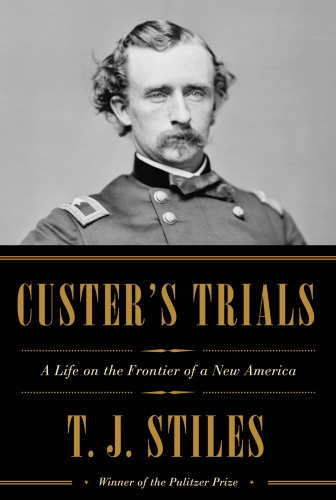
Custer's Trials
A Life on the Frontier of a New America
کتاب های مرتبط
- اطلاعات
- نقد و بررسی
- دیدگاه کاربران
نقد و بررسی

Starred review from August 31, 2015
Stiles, winner of a National Book Award and a Pulitzer Prize for 2009’s The First Tycoon, grounds this spectacular narrative of George Armstrong Custer in skillful research to deliver a satisfying portrait of a complex, controversial military man. The biography centers on the importance of period context in understanding character, incisively showing that Custer lived uncomfortably on a “chronological frontier” of great modern change in the U.S. Though Custer is best known for his fatal “last stand” at the 1876 Battle of the Little Bighorn, Stiles recounts how the officer first attracted national attention for his cavalry exploits during the Civil War. Stiles also delves into the role of celebrity in Custer’s life, tracing the ebb and flow of his popularity over more than a decade after the war, as Custer struggled to find a prominent place in the “peacetime” army that the U.S. deployed in the West against Native Americans. Custer’s personal life was tumultuous: he was a womanizer before and during his marriage to Libbie Bacon, and their home life was complicated by the presence of a freed bondswoman as well as persistent rumors that he had taken a captive Cheyenne woman as his “mistress.” Confidently presenting Custer in all his contradictions, Stiles examines the times to make sense of the man—and uses the man to shed light on the times. Illus.

August 1, 2015
Pulitzer Prize and National Book Award winner Stiles (The First Tycoon: The Epic Life of Cornelius Vanderbilt, 2009, etc.) gives a warts-and-all portrait of Gen. George Armstrong Custer (1839-1876), giving full rein to both his admirers and critics. Custer graduated at the bottom of his West Point class in 1861 with the most demerits of any of the students. Only the demerits foreshadowed the brilliant tactician's future. In the first half of the book, the author provides an excellent chronicle of Civil War battles and the politics of war. Custer's undisputed prowess as a cavalry officer in the war fed his ambitions. He gained a place on George McClellan's staff that would prove especially deleterious. His flamboyance, velvet uniform, and slouching hat might have made him a laughingstock, but his ability was real and his courage, sincere. His knowledge of tactics and ability to read his environment gained him promotions and celebrity. He led from the front, but he was incapable of management. His postwar assignments in Texas and Kansas brought out the cruel, tyrannical man who abused and humiliated his men. His published writings chronicle his fascination with natural history, but they provided little income. He dabbled in the railroads and a silver mine venture, and he gambled on stock speculation. Stiles ably points out his many defining flaws: his heroic style didn't work in an era of tact and skill, and there is no doubt that he was self-serving, generally assuming that rules weren't made for him and never showing remorse. In addition to examining Custer's life, the author also introduces his cook, the fascinating Eliza Brown, an escaped slave who deserves a biography of her own. Stiles digs deep to deliver genuine insight into a man who never adapted to modernity. The author confirms, but perhaps excuses, the worldview of the "boy general with the golden locks."
COPYRIGHT(2015) Kirkus Reviews, ALL RIGHTS RESERVED.

September 1, 2015
Pulitzer Prize-winning author Stiles (The First Tycoon) doesn't disappoint with this powerful, provocative biography of George Armstrong Custer (1839-76). Determined to explore why Custer became a national celebrity, Stiles covers the entire life of "The Boy General," emphasizing the dynamism of Custer's life and times, rather than portraying him as on a slow march toward defeat and death at the Battle of the Little Bighorn (Custer's Last Stand), where Lakota and Northern Cheyenne warriors proved victorious in June 1876. Custer was an outstanding cavalry officer in Civil War battles, and his ascent to power is chronicled in the first half of the book while the latter narrative portrays its subject as a romantic war hero addressing the realities of a brutal westward Indian campaign. The historical context of 19th-century America becomes as much a part of the story as is Custer, his wife, Libbie, and Eliza Brown, a young escaped slave who became their household manager. VERDICT A highly recommended modern biography that successfully illuminates the lives of Custer and his family as part of the changing patterns of American society. [See Prepub Alert, 4/20/15.]--Nathan Bender, Albany Cty. P.L., Laramie, WY
Copyright 2015 Library Journal, LLC Used with permission.

May 15, 2015
Stiles, winner of both the National Book Award and the Pulitzer Prize for The First Tycoon, here shows us how George Armstrong Custer summed up the crosscurrents of his era; he fought for emancipation while denying racial equality and remained an authority-bucking individualist (twice court-martialed) as America consolidated and industrialized. The tug-of-war relationship between the Custers and their housekeeper, escaped slave Eliza Brown, is central to the book. With a 75,000-copy first printing.
Copyright 2015 Library Journal, LLC Used with permission.

























دیدگاه کاربران